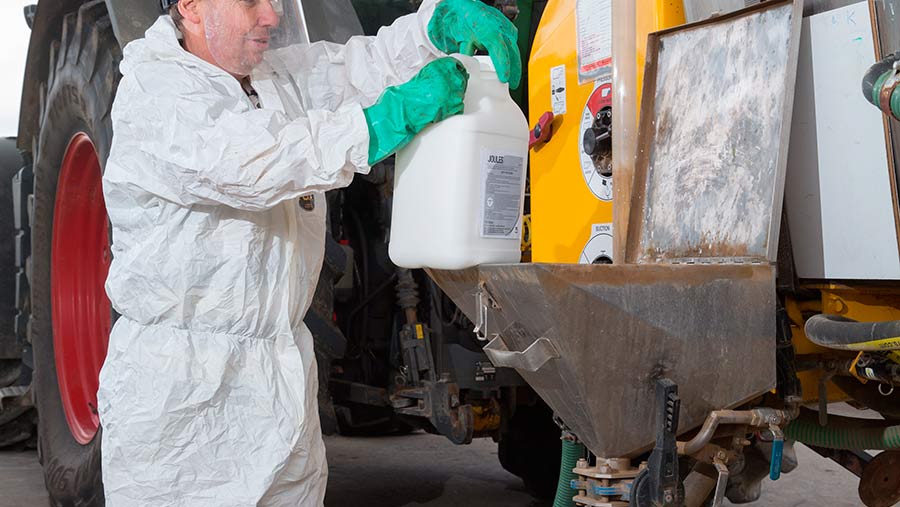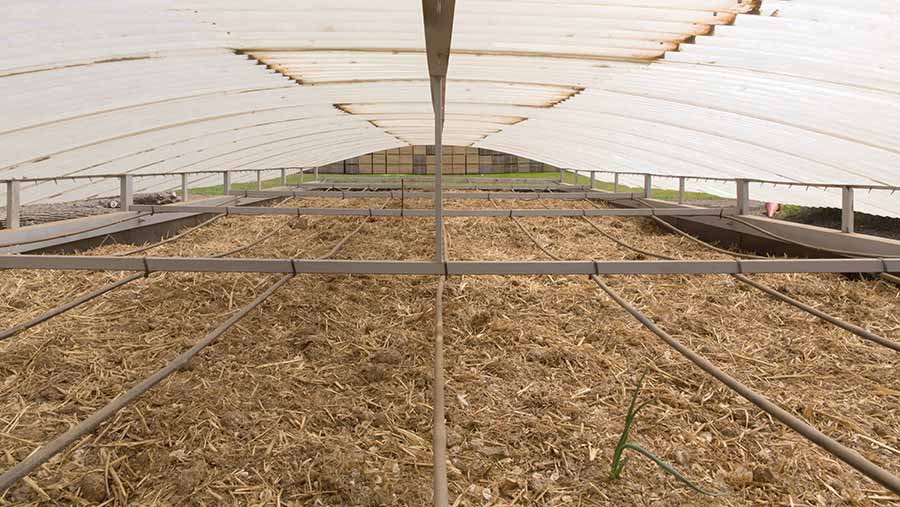How more arable farmers can benefit from biobeds
 © Tim Scrivener
© Tim Scrivener It’s nearly 10 years since the Environment Agency gave the green light to biobeds for treating sprayer washings. There are now an estimated 450 in the UK, helping reduce the risk of pesticides reaching water.
Globally, only France, Sweden and Guatemala have more than the UK, with France leading the way with 4,500, encouraged by generous grants.
See also: Two farmers give their tips for building the perfect sprayer filling area
However, given that there are about 20,000 registered sprayer operators and more than 16,000 sprayers were tested in the UK last year, independent consultant Bill Basford suggests many more farmers could benefit.
Patrick Goldsworthy of the Voluntary Initiative agrees, saying biobeds and biofilters are being underused in the UK. However, he points out that they are not the only choice for handling washings.
Many farmers do a lot of their washing (and filling) in the field and/or on a grassy/cropped area.
Others have a dedicated concrete filling area and collect washings in a sump and then spray out on to an area with groundwater approval. Some pay for professional disposal, which is expensive.
However, Mr Goldsworthy says there are a number of farmers who may just wash down on a hardstanding and haven’t got around to sorting out their handling area. They especially need to consider upgrading their facilities.
What are biobeds?

Biofilter © Tim Scrivener
Lined biobeds are essentially pits of mixed straw, compost and soil that can degrade pesticides and stop them getting into watercourses.
A biofilter is a more compact version, consisting of three interconnected boxes stacked on top of each other filled with the soil mix. They treat smaller volumes than biobeds.
In an ideal set-up, biobeds are coupled with a bunded-concrete filling area, but the latest trend, according to Mr Basford, is to have a roofed filling area with a biofilter.
“Rainfall can account for 22-42cu m of water for a filling area, so with a roof, you are only talking about 5cu m annually. A biofilter will cope with this volume.”
Flat-packs are available, making installation even easier for both. Biofilters cost about £990 and a biobed about £2,250.
Role of biobeds
Biobeds can have a valuable role given that losses from filling areas can in some cases account for more than 80% of detections in a catchment, while at a national scale, it is nearer 40%.

Biobed © Tim Scrivener
Katherine Filby of Severn Trent Water’s catchment team points to two examples of how pesticides have had a significant cost to the business.
The first is Draycote reservoir, where the oilseed rape herbicide active quinmerac was found at 0.2ppb. The water treatment plant had to close and water was sourced from elsewhere.
In another example in Derbyshire, grassland herbicides 2,4-D and MCPA levels were above EU standards for three months and it was a waiting game for levels to fall through dilution, says Dr Kilby.
Treatment will remove certain pesticides, but some, such as quinmerac, are difficult to remove from water.
On top of this, EU legislation requires that investment in treatment to remove pesticides in water should decline, which is why water companies are focusing on reducing levels in surface water so it needs less treatment.
Teresa Meadows of Essex and Suffolk Water explains that the company has built four demo sites (three biobeds and one biofilter) and held more than 70 events. To date, it has resulted in more than 50 installations within its catchments.
The water company has also researched how effective biobeds and one biofilters are and put together advice on how farmers can get the most from them (see below).
How to get the most out of your biobed/filter
To help existing users, Essex and Suffolk Water has put together advice gained through on-farm research work with both biobeds and biofilters.
- Wash the sprayer and associated equipment in the field wherever possible, away from watercourses and land drains.
- Keep the concrete sprayer filling area pad as clean from mud as possible. This will help prevent the drip irrigation pipes from blocking.
- Keep the biomix (50% straw, 25% soil, 25% compost) topped up to a minimum depth of 1m.
- Avoid overloading the biobed or biofilter with large volumes of water at any one time. Where this is necessary (such as when pressure washing the sprayer), aim to regulate the flow to allow small volumes at a time – for example, include a timer linked to the pump in the first collection tank.
- Manage the levels of input to the biobed or biofilter during particularly cold temperatures. The biomix can be less effective during these times and so distribution of water during this period should be minimised, where possible.
- Ensure the final irrigation water is to a vegetated area, away from land drains and watercourses. Alternatively, recirculate through the system – particularly useful for biofilters to keep the biomix moist and functioning well.
Sampling results have confirmed their effectiveness, with 93% of propyzamide removed. Other actives have also seen good removal, including 98% of MCPA, 99% of carbetamide and 86% bentazone.
However, clopyralid removal was less effective, with an average of 51% removed.
“We think what is happening is that it attaches to the mixture and then slowly leaches off over time. This highlights the importance of irrigation [of the final discharge water] on these sites,” she says.
For more information on irrigation specs, consult the Voluntary Initiative’s Biobed and Biofilter Manual. This outlines the standards which installations must meet.
Biobeds grant aid
There are two sources of grant funding available for growers, covering about half the cost of installing a biobed or biofilter.
- Catchment Sensitive Farming offers growers in priority catchment areas grant funding for biobeds, biofilters and filling areas. For more information, consult your local CSF officer. More details can be found on the Catchment Sensitive Farming website.
- Severn Trent Water’s Steps scheme pays a fixed grant price per item up to a maximum of £5,000, but growers will need to be in a Severn Trent Water priority catchment area. Funding is available for another three years. More information is available on Severn Trent Water’s website.

